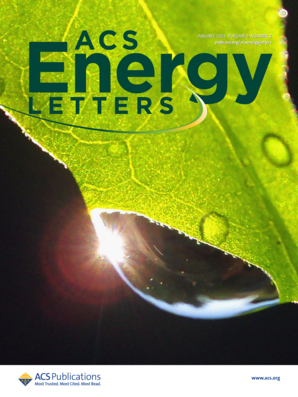PTAA/Perovskite Contact-Area Reduced Solar Modules
IF 19.3
1区 材料科学
Q1 CHEMISTRY, PHYSICAL
引用次数: 0
Abstract
Scalable fabrication of perovskite solar cells (PSCs) in ambient air is important toward widespread industrial adoption. While spiro-OMeTAD-based PSCs perform well, they lack long-term stability, and alternative hole transport layers often trade efficiency for durability. Here we report high molecular weight poly(triarylamine) (HMW PTAA)-based PSCs fabricated in ambient air using scalable techniques, achieving 23.7% efficiency for 0.049 cm2 solar cells and 22.2% for 10.23 cm2 mini-modules, representing, to our knowledge, the highest values reported for scalable n-i-p PTAA-based perovskite photovoltaics made in ambient conditions. The HMW PTAA spontaneously forms a contact-area-reduced (CAR) interface with perovskite, enhancing charge collection and suppressing recombination. Despite reduced adhesion, the CAR interface improves PSC stability; devices retain 83% of their efficiency after 1000 h of operation at maximum power point at 55 ± 5 °C, and 77% after 1100 h of thermal stress at 85 °C. We attribute this resilience to strain-relieving interfacial voids created by the CAR interface.

减少PTAA/钙钛矿接触面积的太阳能组件
环境空气中钙钛矿太阳能电池(PSCs)的规模化制造对于广泛的工业应用至关重要。虽然基于sproo - ometad的psc性能良好,但它们缺乏长期稳定性,替代的空穴传输层通常以效率为代价换取耐用性。在这里,我们报道了使用可扩展技术在环境空气中制造的高分子量聚(三芳胺)(HMW PTAA)基PSCs,在0.049 cm2的太阳能电池中实现了23.7%的效率,在10.23 cm2的微型组件中实现了22.2%的效率,据我们所知,这是在环境条件下制造的可扩展n-i-p PTAA基钙钛矿光伏电池的最高值。HMW PTAA与钙钛矿自发形成接触面积还原(CAR)界面,增强电荷收集并抑制复合。尽管减少了粘附,但CAR界面提高了PSC的稳定性;在55±5℃的最大功率点下工作1000 h后,器件效率保持83%,在85℃的热应力下工作1100 h后,效率保持77%。我们将这种弹性归因于由CAR界面产生的应力释放界面空隙。
本文章由计算机程序翻译,如有差异,请以英文原文为准。
求助全文
约1分钟内获得全文
求助全文
来源期刊

ACS Energy Letters
Energy-Renewable Energy, Sustainability and the Environment
CiteScore
31.20
自引率
5.00%
发文量
469
审稿时长
1 months
期刊介绍:
ACS Energy Letters is a monthly journal that publishes papers reporting new scientific advances in energy research. The journal focuses on topics that are of interest to scientists working in the fundamental and applied sciences. Rapid publication is a central criterion for acceptance, and the journal is known for its quick publication times, with an average of 4-6 weeks from submission to web publication in As Soon As Publishable format.
ACS Energy Letters is ranked as the number one journal in the Web of Science Electrochemistry category. It also ranks within the top 10 journals for Physical Chemistry, Energy & Fuels, and Nanoscience & Nanotechnology.
The journal offers several types of articles, including Letters, Energy Express, Perspectives, Reviews, Editorials, Viewpoints and Energy Focus. Additionally, authors have the option to submit videos that summarize or support the information presented in a Perspective or Review article, which can be highlighted on the journal's website. ACS Energy Letters is abstracted and indexed in Chemical Abstracts Service/SciFinder, EBSCO-summon, PubMed, Web of Science, Scopus and Portico.
 求助内容:
求助内容: 应助结果提醒方式:
应助结果提醒方式:


